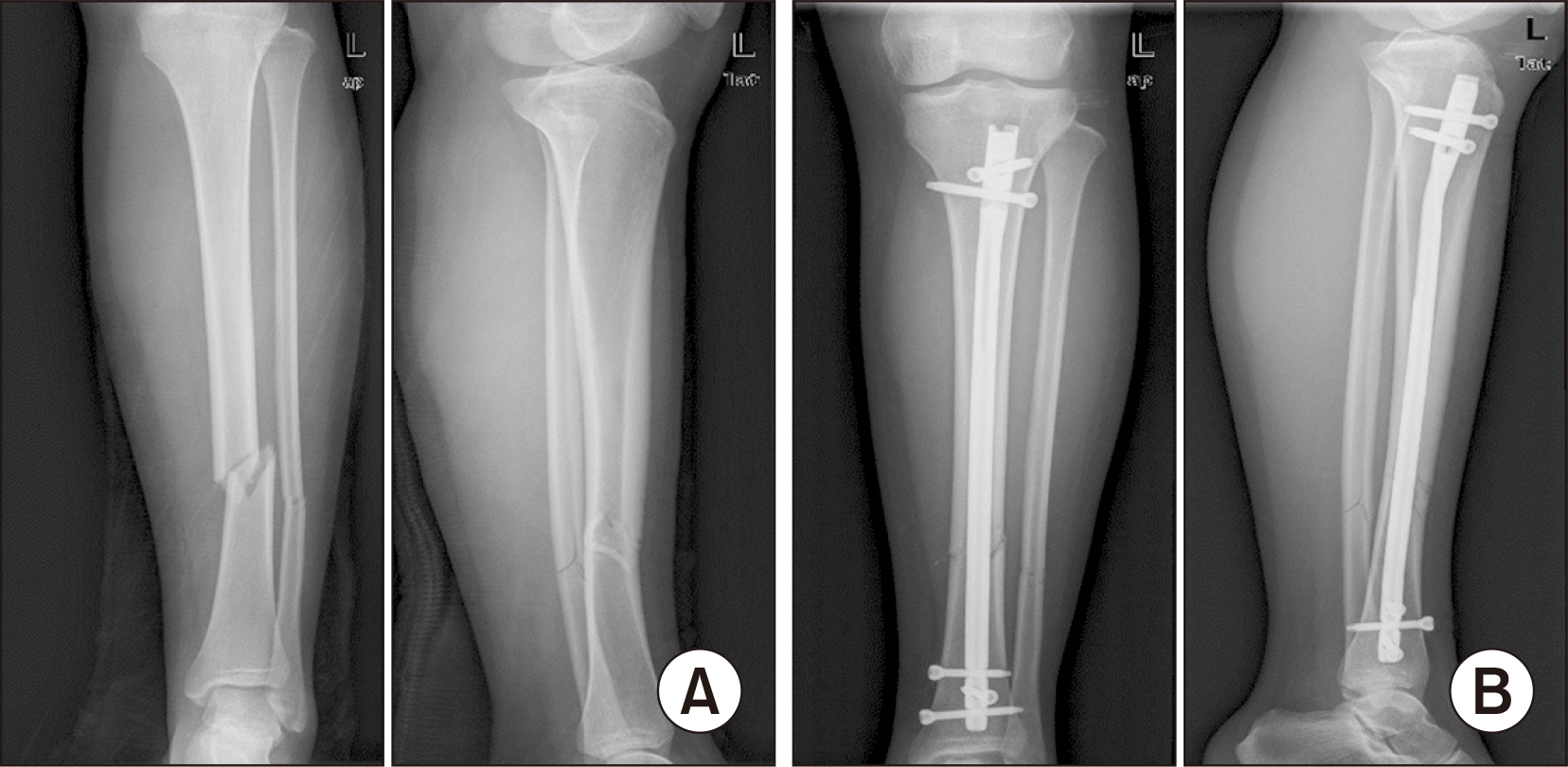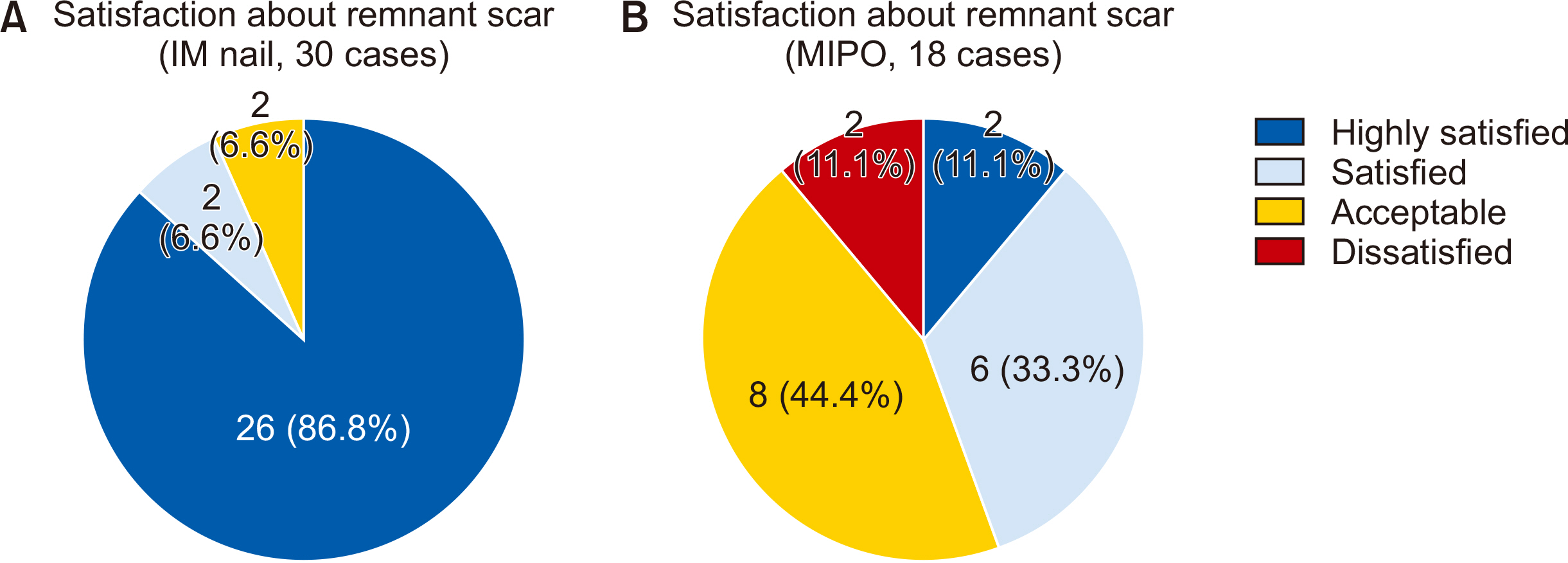J Korean Foot Ankle Soc.
2023 Sep;27(3):93-98. 10.14193/jkfas.2023.27.3.93.
Intramedullary Nailing versus Minimally Invasive Plate Osteosynthesis for Distal Tibia Shaft Fractures: Retrospective Comparison of Functional and Cosmetic Outcomes
- Affiliations
-
- 1Department of Orthopedic Surgery, National Police Hospital, Seoul, Korea
- KMID: 2545987
- DOI: http://doi.org/10.14193/jkfas.2023.27.3.93
Abstract
- Purpose
This study compared the functional and cosmetic treatment outcomes of intramedullary nailing (IM nail) and minimally invasive plate osteosynthesis (MIPO) for distal tibia shaft fractures.
Materials and Methods
Forty-eight patients with distal tibia shaft fractures (distal 1/3 of the diaphysis, AO/OTA [AO Foundation/ Orthopaedic Trauma Association]) 43 managed by an IM nail (n=30) or MIPO (n=18) who had minimum one-year follow-up were enrolled in this study. The radiological, functional, and cosmetic outcomes in the two groups were compared retrospectively.
Results
All patients achieved bone union. The mean bone union time of the IM nail and MIPO groups was 18.5 and 22.6 weeks, respectively (p=0.078). One patient in the MIPO group showed posterior angulation and valgus deformity of more than five degrees. The mean American Orthopaedic Foot and Ankle Society (AOFAS) functional scores were similar: 83.3 in the IM nail group and 84.6 in the MIPO group (p=0.289). The most salient difference was the cosmetic result of the surgical scar. The length of the scars around the ankle in the IM nail group was significantly smaller than the MIPO group (2.6 cm vs. 10.6 cm; p=0.035). The patient satisfaction survey of surgical scars revealed a significantly higher satisfaction rate in the IM nail group than in the MIPO group (93% vs. 44%; p<0.001).
Conclusion
This study showed that both treatment methods for distal tibia shaft fractures have similar therapeutic efficacy regarding the radiological and functional outcomes. On the other hand, the IM nail technique showed superior cosmetic outcomes than the MIPO technique. IM nails may be more recommended in patients with high demand for cosmetic results.
Keyword
Figure
Reference
-
1. Wyrsch B, McFerran MA, McAndrew M, Limbird TJ, Harper MC, Johnson KD, et al. 1996; Operative treatment of fractures of the tibial plafond. A randomized, prospective study. J Bone Joint Surg Am. 78:1646–57. doi: 10.2106/00004623-199611000-00003. DOI: 10.2106/00004623-199611000-00003. PMID: 8934478.
Article2. Robinson CM, McLauchlan GJ, McLean IP, Court-Brown CM. 1995; Distal metaphyseal fractures of the tibia with minimal involvement of the ankle. Classification and treatment by locked intramedullary nailing. J Bone Joint Surg Br. 77:781–7. DOI: 10.1302/0301-620X.77B5.7559711. PMID: 7559711.
Article3. Kuhn S, Hansen M, Rommens PM. 2007; Extending the indication of intramedullary nailing of tibial fractures. Eur J Trauma Emerg Surg. 33:159–69. doi: 10.1007/s00068-007-7039-z. DOI: 10.1007/s00068-007-7039-z. PMID: 26816146.
Article4. Scolaro JA, Broghammer FH, Donegan DJ. 2016; Intramedullary tibial nail fixation of simple intraarticular distal tibia fractures. J Orthop Trauma. 30 Suppl 4:S12–6. doi: 10.1097/BOT.0000000000000697. DOI: 10.1097/BOT.0000000000000697. PMID: 27768627.
Article5. Beytemür O, Albay C, Adanır O, Yüksel S, Güleç MA. 2016; Is intramedullary nailing applicable for distal tibial fractures with ankle joint extension? Eklem Hastalik Cerrahisi. 27:125–31. doi: 10.5606/ehc.2016.27. DOI: 10.5606/ehc.2016.27. PMID: 27902166.
Article6. Nork SE, Schwartz AK, Agel J, Holt SK, Schrick JL, Winquist RA. 2005; Intramedullary nailing of distal metaphyseal tibial fractures. J Bone Joint Surg Am. 87:1213–21. doi: 10.2106/JBJS.C.01135. DOI: 10.2106/JBJS.C.01135. PMID: 15930529.
Article7. Collinge C, Sanders R, DiPasquale T. Treatment of complex tibial periarticular fractures using percutaneous techniques. Clin Orthop Relat Res. 2000; (375):69–77. doi: 10.1097/00003086-200006000-00009. DOI: 10.1097/00003086-200006000-00009. PMID: 10853155.
Article8. Redfern DJ, Syed SU, Davies SJ. 2004; Fractures of the distal tibia: minimally invasive plate osteosynthesis. Injury. 35:615–20. doi: 10.1016/j.injury.2003.09.005. DOI: 10.1016/j.injury.2003.09.005. PMID: 15135282.
Article9. Paluvadi SV, Lal H, Mittal D, Vidyarthi K. 2014; Management of fractures of the distal third tibia by minimally invasive plate osteosynthesis - a prospective series of 50 patients. J Clin Orthop Trauma. 5:129–36. doi: 10.1016/j.jcot.2014.07.010. DOI: 10.1016/j.jcot.2014.07.010. PMID: 25983486. PMCID: PMC4223765.
Article10. Kang H, Rho JY, Song JK, Choi J, Kwon YS, Choi S. 2021; Comparison between intramedullary nailing and minimally invasive plate osteosynthesis for tibial shaft fractures. Injury. 52:1011–6. doi: 10.1016/j.injury.2021.01.038. DOI: 10.1016/j.injury.2021.01.038. PMID: 33563414.
Article11. Saied A, Ostovar M, Mousavi AA, Arabnejhad F. 2016; Comparison of intramedullary nail and plating in treatment of diaphyseal tibial fractures with intact fibulae: a randomized controlled trial. Indian J Orthop. 50:277–82. doi: 10.4103/0019-5413.181793. DOI: 10.4103/0019-5413.181793. PMID: 27293288. PMCID: PMC4885296.12. Janssen KW, Biert J, van Kampen A. 2007; Treatment of distal tibial fractures: plate versus nail: a retrospective outcome analysis of matched pairs of patients. Int Orthop. 31:709–14. doi: 10.1007/s00264-006-0237-1. DOI: 10.1007/s00264-006-0237-1. PMID: 17160683. PMCID: PMC2266640.13. Polat A, Kose O, Canbora K, Yanık S, Guler F. 2015; Intramedullary nailing versus minimally invasive plate osteosynthesis for distal extra-articular tibial fractures: a prospective randomized clinical trial. J Orthop Sci. 20:695–701. doi: 10.1007/s00776-015-0713-9. DOI: 10.1007/s00776-015-0713-9. PMID: 25790936.
Article14. Vallier HA, Le TT, Bedi A. 2008; Radiographic and clinical comparisons of distal tibia shaft fractures (4 to 11 cm proximal to the plafond): plating versus intramedullary nailing. J Orthop Trauma. 22:307–11. doi: 10.1097/BOT.0b013e31816ed974. DOI: 10.1097/BOT.0b013e31816ed974. PMID: 18448983.
Article15. Guo JJ, Tang N, Yang HL, Tang TS. 2010; A prospective, randomised trial comparing closed intramedullary nailing with percutaneous plating in the treatment of distal metaphyseal fractures of the tibia. J Bone Joint Surg Br. 92:984–8. doi: 10.1302/0301-620X.92B7.22959. DOI: 10.1302/0301-620X.92B7.22959. PMID: 20595119.
Article16. Fisher WD, Hamblen DL. 1978; Problems and pitfalls of compression fixation of long bone fractures: a review of results and complications. Injury. 10:99–107. doi: 10.1016/s0020-1383(79)80069-8. DOI: 10.1016/S0020-1383(79)80069-8. PMID: 730343.
Article17. Collinge C, Protzman R. 2010; Outcomes of minimally invasive plate osteosynthesis for metaphyseal distal tibia fractures. J Orthop Trauma. 24:24–9. doi: 10.1097/BOT.0b013e3181ac3426. DOI: 10.1097/BOT.0b013e3181ac3426. PMID: 20035174.
Article18. Lee HM, Kim YS, Kim JP, Chung PH, Kang S, Jo KS. 2018; Comparative analysis of minimally invasive plate osteosynthesis and intramedullary nailing in the treatment of the distal tibia fractures. J Korean Fract Soc. 31:94–101. doi: 10.12671/jkfs.2018.31.3.94. DOI: 10.12671/jkfs.2018.31.3.94.
Article19. Liu XK, Xu WN, Xue QY, Liang QW. 2019; Intramedullary nailing versus minimally invasive plate osteosynthesis for distal tibial fractures: a systematic review and meta-analysis. Orthop Surg. 11:954–65. doi: 10.1111/os.12575. DOI: 10.1111/os.12575. PMID: 31823496. PMCID: PMC6904655.20. Zou J, Zhang W, Zhang CQ. 2013; Comparison of minimally invasive percutaneous plate osteosynthesis with open reduction and internal fixation for treatment of extra-articular distal tibia fractures. Injury. 44:1102–6. doi: 10.1016/j.injury.2013.02.006. DOI: 10.1016/j.injury.2013.02.006. PMID: 23473266.
Article21. Mao Z, Wang G, Zhang L, Zhang L, Chen S, Du H, et al. 2015; Intramedullary nailing versus plating for distal tibia fractures without articular involvement: a meta-analysis. J Orthop Surg Res. 10:95. doi: 10.1186/s13018-015-0217-5. DOI: 10.1186/s13018-015-0217-5. PMID: 26078031. PMCID: PMC4481115.
Article
- Full Text Links
- Actions
-
Cited
- CITED
-
- Close
- Share
- Similar articles
-
- Comparison of Results between Minimally Invasive Plate Fixation and Antegrade Intramedullary Nailing of Recon-Type in Low-Energy Injury Distal Femoral Shaft Fractures
- The Comparison of Minimally Invasive Plate Osteosynthesis and Intramedullary Nailing in the Treatment of the Proximal and Distal Tibia Fracture
- A Comparison of the Results between Intramedullary Nailing and Minimally Invasive Plate Osteosynthesis in Distal Tibia Fractures
- Clinical Outcome after Treatment of Tibia Segmental Fracture with Intramedullary Nailing and Minimal Invasive Plate Osteosynthesis
- Comparative Analysis of Minimally Invasive Plate Osteosynthesis Using Periarticular Plate and Intramedullary Nailing in Distal Tibial Metaphyseal Fractures





